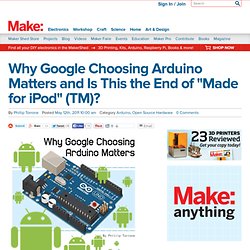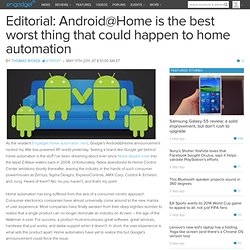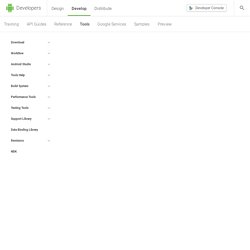

Why Google Choosing Arduino Matters and is This the End of “Made for iPod” (TM)? This week is the yearly Google I/O at the Moscone Center in San Francisco.

It’s a meet and greet for lots of people and companies, a big dot-com over-the-top party, and most of all it’s geared towards “web, mobile, and enterprise developers building applications in the cloud with Google and open web technologies… Products and technologies to be featured at I/O include App Engine, Android, Google Web Toolkit, Google Chrome, HTML5, AJAX and Data APIs, Google TV, and more.” Maybe not so much Google TV or Google Wave this year :) but for open hardware and mobile folks, this was one of the most important weeks in history. In this week’s column, I’m going to talk about Google choosing the open source hardware platform (Arduino) for the “Android Open Accessory” kit, and why this matters.
I’m also going to talk a little about how Google could make it better. If mobile companies want to see the phone market blossom with creativity, with accessories never imagined, this is how it can happen. Editorial: Android@Home is the best worst thing that could happen to home automation. As the resident Engadget home automation nerd, Google's Android@Home announcement rocked my little low-powered RF world yesterday.

Seeing a brand like Google get behind home automation is the stuff I've been dreaming about ever since Nokia dipped a toe into the tepid Z-Wave waters back in 2008. Unfortunately, Nokia abandoned its Home Control Center ambitions shortly thereafter, leaving the industry in the hands of such consumer powerhouses as Zensys, Sigma Designs, ExpressControls, AMX Corp, Control 4, Echelon, and Jung. Heard of them? No, no you haven't, and that's my point. Home automation has long suffered from the lack of a consumer-centric approach. It's with open arms that I welcome Google into my home, that I willingly prostrate myself at the feet of Matias Duarte. So far the company has promised partnerships with "several industry players" but has only demonstrated a prototype wireless lightbulb from Lighting Science and an Android@Home media hub.
Comments. Exclusive interview: Google's Matias Duarte talks Honeycomb, tablets, and the future of Android. Google’s Plan to Take Android Everywhere: Tech News and Analysis « Call it real-world domination, or simply Android Everywhere: Google unveiled two initiatives at its I/O developer conference on Tuesday that hint at plans to take Android well beyond the mobile and tablet device space.

The Arduino-powered Android ADK. The first part of the puzzle was the unveiling of the Android Accessory Mode, which makes it possible for third-party developers to build hardware accessories that can communicate with Android devices via USB. One of the applications demonstrated by Google included game controllers for Android devices, and companies exhibiting at I/O showcased the use of Google’s reference Accessory Development Kit (ADK) to play music, grow plants and control robots.
All of this may admittedly sound pretty geeky, and Google was clearly targeting hardware hackers at I/O, giving away development kits that are based on the Arduino open source hardware. The gateway used by Lighting Science to connect an Android tablet to mesh-networked LEDs. Open Accessory Development Kit. The Accessory Development Kit (ADK) is a reference implementation for hardware manufacturers and hobbyists to use as a starting point for building accessories for Android.

Each ADK release is provided with source code and hardware specifications to make the process of developing your own accessories easier. Creating new and alternative hardware based on the ADK is encouraged! Android accessories can be audio docking stations, exercise machines, personal medical testing devices, weather stations, or any other external hardware device that adds to the functionality of Android. Accessories use the Android Open Accessory (AOA) protocol to communicate with Android devices, over a USB cable or through a Bluetooth connection.
If you are building an accessory that uses USB, make sure you understand how to implement the AOA protocol to establish communication between your accessory hardware and Android. ADK 2012 Guide Guide to getting started with the ADK released at Google I/O 2012. ADK 2011 Guide. Google I/O 2011 - Connecting Android to Real World Robotics using Open Accessory.